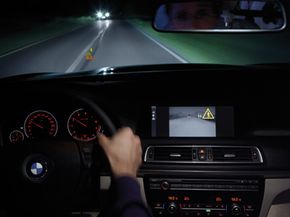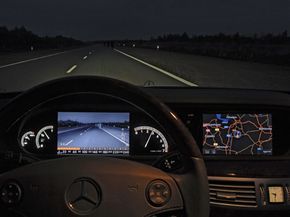How many cool movies have you seen where a secret agent drives an exotic car through the mountains without any headlights? Or a low-flying AH-64 Apache pilot who moves in for a kill in pitch blackness? What about the urban legend of the 200-mile per hour (322 kilometers per hour) Lamborghini used from making covert drug runs at night, all the while escaping detection under a blanket of darkness? All of these images stem from the concept of night vision.
Perhaps the most common application for night vision is military. Soldiers like the one flying the Apache rely on night vision goggles as much as they rely on weapons and training. In short, night vision brings daylight to darkness. Pilot vision, rifle vision for soldiers and even driver vision are all cutting-edge applications for night vision technologies.
Advertisement
In this article, we'll look at night vision systems found in production cars. We won't be busting the case on the mythical Lamborghini, but you will understand how two of the leading manufacturers in the auto industry are taking back the night in attempt to make driving in the dark safer. In recent years, multiple studies have been conducted in the United States as well as Europe and they all seem to paint the same general picture: The majority of driving is done with the aid of daylight, yet a high volume of fatal accidents occur at night.
If you've ever driven on a desolate road outside of the city and seen a deer or other type of nocturnal animal flash across your headlights, then you know just how poor night visibility can be. Wouldn't it be nice if you could see what's up ahead, or even alongside the road while driving after sundown? The individual brain-trusts at BMW, Mercedes, Toyota and General Motors think that would be a good idea, too. That's why each has taken a crack at developing night vision systems.
Let's get started by learning the basics of night vision and take a look at early attempts at in-dash night-vision systems on the next page.
Advertisement




